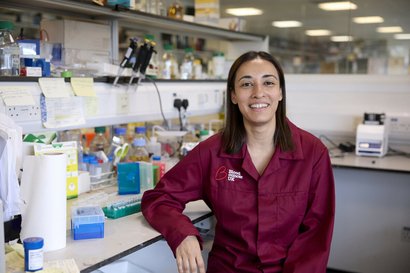Treatment for MALT lymphoma
Treatment aims to get rid of the lymphoma and keep you in remission (where tests show no sign of the lymphoma) for as long as possible.
Planning your treatment
There’s a range of treatment options for MALT lymphoma. Your hospital team will recommend the best treatment for you, based on:
- your test results
- whether the MALT lymphoma is caused by an infection
- whether you have gastric or non-gastric MALT lymphoma
- the stage of the lymphoma
- your general health and fitness.
Active monitoring (watch and wait)
Some people who are diagnosed with MALT lymphoma don’t need treatment straight away. This is called active monitoring, also known as watch and wait.
If you have a slow growing (low grade) type of lymphoma and have few or no symptoms, active monitoring is a good approach. There is no evidence to suggest that having treatment earlier will help, and it is better to keep all options open and wait until treatment is needed.
You will have regular tests to check whether the lymphoma is progressing. If you start to show symptoms or there are signs of progression, your team may decide to start you on active treatment.
Some people can go months or years on active monitoring. During this time, doctors may give you advice on staying well, such as ways you can reduce your risk of infection and keep healthy, active, and strong.
Living with the uncertainty and emotional impact of active monitoring can affect you emotionally. Many people find it helpful to connect with others in a similar position through support groups like our online community forum, where you can find conversations about being on active monitoring (or watch and wait).
Our living with MALT lymphoma page also gives advice on how you can cope both physically and emotionally, including when you are on active monitoring.
Antibiotics
Gastric MALT lymphoma
For people with gastric MALT lymphoma, the first treatment is usually antibiotics. Antibiotics aim to treat the H. pylori stomach infection that typically causes gastric MALT lymphoma.
If you have this treatment, you will take a course of two antibiotics and an acid reducing medication. This is sometimes called triple therapy.
Your doctor will advise you how often and how long to take the medication for.
You may then be offered a breath test or a stool test around 4-8 weeks after you have finished taking the medicine to check if the H. pylori has been treated.
You may also have an endoscopy around 3-6 months after treatment to make sure the lymphoma has not returned.
You are likely to have regular check-ups and endoscopies to check that the lymphoma stays in remission.
Antibiotics are successful at treating most people with gastric MALT lymphoma. Some people need several rounds of antibiotics before the lymphoma starts to improve, and it can take up to a year to see results.
If some of the lymphoma remains after antibiotic treatment, you may have further treatment such as radiotherapy or chemo-immunotherapy, or doctors may decide to put you on active monitoring.
Non-gastric MALT lymphoma
Antibiotics are the first treatment for people with non-gastric MALT lymphoma if it is linked to a bacterial infection. It is also recommended for people with MALT lymphoma that affects the eyes.
If doctors don’t find evidence of an infection, and if treatment is recommended, then non-gastric MALT lymphoma is likely to be treated with radiotherapy or chemo-immunotherapy.

Talk to other people affected by blood cancer
Hear from and connect with people who understand.
Radiotherapy
If you have MALT lymphoma that is not caused by an infection, or hasn’t responded to antibiotics, doctors might consider treating you with radiotherapy.
Radiotherapy is a type of treatment that uses high energy rays to destroy cancer cells in a particular area of the body. You don’t normally feel anything when you have radiotherapy. You will go into hospital for the treatment but won’t need to stay in overnight.
This kind of treatment can be very effective for people who have localised MALT lymphoma, meaning it is limited to one or just a few areas of the body. Radiotherapy can be targeted accurately to the site of the lymphoma, which helps prevent damage to healthy cells and nearby organs.
Your treatment team will tell you how often you should expect to have radiotherapy and how many treatments you will need.
Radiotherapy isn’t suitable for people where MALT lymphoma is more widespread.
Chemo-immunotherapy
A combination of chemotherapy and immunotherapy (known as chemo-immunotherapy) is used to treat MALT lymphoma. This type of treatment can be used if you have MALT lymphoma that is not linked to an infection or hasn’t responded to antibiotics.
Immunotherapy drugs
These help your immune system to find and destroy cancer cells. Some are also targeted therapies, which specifically target cancer cells and don’t damage healthy cells.
In MALT lymphoma, a targeted immunotherapy drug called rituximab is used. Rituximab binds to specific proteins on the surface of abnormal lymphocytes. This blocks their growth and tags the cells, making it easier for the immune system to find and destroy them.
Rituximab is usually combined with types of chemotherapy.
Chemotherapy
Chemotherapy uses cytotoxic (cancer-killing) drugs to disrupt the growth of abnormal cells. The type of chemotherapy you may have in MALT lymphoma can vary.
Research has shown that these drug combinations can work well against MALT lymphoma:
- Rituximab and bendamustine (a chemotherapy drug)
- Rituximab and chlorambucil (a chemotherapy drug)
- R-CVP – a combination of rituximab, the chemotherapy drugs cyclophosphamide and vincristine and a steroid called prednisone
- R-CHOP – a combination of rituximab, the chemotherapy drugs cyclophosphamide, doxorubicin and vincristine, and the steroid prednisone.
How you take these drugs and how long you take them for will depend on the type of chemo-immunotherapy you have. The drugs may be given through a drip into a vein (intravenous infusion), as a tablet, or as a small injection under the skin.
Your team will let you know what to expect from chemo-immunotherapy, and you can also read more about treatments for blood cancer.
Surgery
Most people with MALT lymphoma will not have surgery. Sometimes, doctors may recommend an operation to remove a lump if they are confident it is safe. This will depend on the size of the lump and where it is.
Research and clinical trials
A lot of research is going on to understand MALT lymphoma and other low grade non-Hodgkin lymphomas and learn how to treat them better. Carefully designed clinical trials play an important part in this research.
Treatments currently being looked at include targeted drugs such as inhibitors (cancer growth blockers) and monoclonal antibodies.
You might have the opportunity to take part in clinical research trials. If this is an option, your doctor will explain what this will involve and answer any questions you have.
It is your choice whether you take part in a trial. If you decide not to, you will still receive the best possible treatment available.
To find out more, look at our information about clinical trials or call our free Clinical Trials Support Service.
After treatment
Once you have finished treatment, your team will check how well it has worked. This involves having tests such as an endoscopy, blood test, breath test or another scan, depending on what type of MALT lymphoma you were diagnosed with.
If there is no evidence of lymphoma in your body, you are said to be in complete remission. Many people with MALT lymphoma have this excellent response to treatment and can remain in remission for a very long time.
During this time, you will have regular follow-up appointments to see:
- how you are recovering from treatment (both physically and mentally)
- if you have any long-term side effects
- if you are showing any symptoms of MALT lymphoma coming back.
You might also have scans and tests for the first few months or years of remission to check on your progress.
You do not have to wait until a follow-up appointment to talk to a doctor if you are concerned about anything – it’s best to get in touch right away even if it’s only to put your mind at rest.
Occasionally, treatment can reduce the lymphoma cells but not clear them. This is known as a partial remission. For a very small number of people, the first treatment does not work at all. This is called a refractory response.
Sometimes, treatment can be successful, but after a period of remission the MALT lymphoma returns. This is called relapse.
Relapses in low grade types of lymphoma like MALT lymphoma are relatively common. This is because there may still be a small amount of very slow growing cells in your body, but the numbers are too low to be picked up during regular testing.
For people who relapse, or have a partial or refractory response, treatment can still be very successful and there are several options. You might have another course of antibiotics (if you have the H. pylori infection), or further treatments such as radiotherapy, chemo-immunotherapy or a different chemotherapy drug. You may have the chance to join a clinical trial and get a new treatment.
Doctors will decide on the best treatment plan for you based on when you last had treatment, the type of lymphoma you have, as well as your symptoms, general health and other medical conditions.

Our research
Our £500 million investment in research since 1960 has helped transform treatments and taken us to the point where beating blood cancer is now in sight. Our researchers are working to finish the job.
More About This